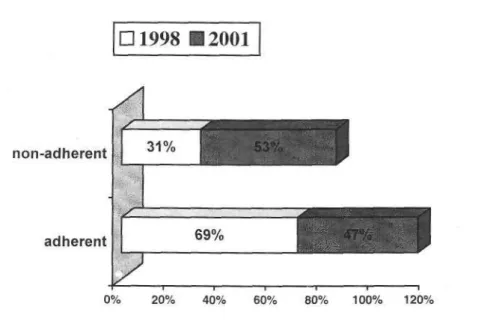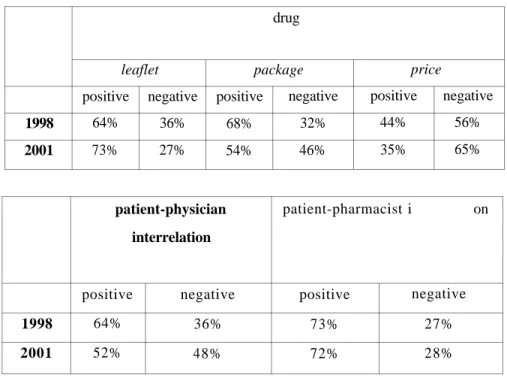THE ASSESSMENT OF THE PHARMACY PATIENTS' COMPLIANCE IN BULGARIA
BULGARİSTAN'DA ECZANEYE BAŞVURAN HASTALARIN UYUNÇ DEĞERLENDİRMESİ
Valentina PETKOVA Zlatka DIMITROVA
Department of Social Pharmacy, Faculty of Pharmacy, medical University, 2-Dunav str., Sofia-1000, Bulgaria. /+359 2/9804430/316/, FAX /+359 2/987 987 4,
e-mail: vpetkova @ mbox.pharmfac. acad. bg ABSTRACT
This issue is an attempt to be compared the compliance among pharmacy patients between the years 1998 and 2001 in Sofia and Bankja, Bulgaria. The authors made an attempt to elucidate the factors that influence the non-compliance of the patients in order to improve it and to increase the rate of compliance among them.
A questionnaire was applied for assessment the state of compliance among the pharmacy patients. The results of the analysis of the received data show that the level of compliance was 69% in 1998 and has decreased to 53% in 2001. The main reasons that influence the non-adherence of the patients are: the high price of the drugs, the overburden daily regimen, negligence, difficulties for application of the drug form, distrust towards the treatment and others.
These researches are the first provided in this area for Bulgaria and they can be a base for further study into great details.
Key words: Medication, compliance, non-compliance, adverse drug reactions, pharmacy
Ö Z E T
Bu makale 1998 ve 2001 yıllarında Bulgaristan'da Sofya ve Bankja'da eczaneye başvuran hastaların oyuncunun çalışmasıdır. Yazarlar, bu uyuncu gösteremeyen hastaların uyunç derecesinin arttırılması için hastaların uyuncunu etkileyen faktörleri araştırdılar.
Eczaneye başvuran hastaların uyunç derecesini değerlendirmek için anket uygulandı. Elde edilen verilerin analiz sonuçları 1998 yılında uyunç derecesinin %69 iken 2001 yılında bu derecenin azalarak %53 'e inmiş olduğunu göstermektedir. Uyunç gösterilemeyişin esas nedenleri şunlardır: ilaçların yüksek fiyatı, fazla yükletilmiş günlük rejimi, ihmalcilik, ilaç reformu tatbikatında güçlükler, tedaviye güvensizlik
v. s.
Bu araştırmalar Bulgaristan için böyle bir alanda yapılan ilk araştırmalar olup daha sonraki daha derin incelemelerin yapılması için bir dayanak oluşturabilir.
INTRODUCTION
Medication-taking behaviors are related to knowledge of medications. Patients do not take their medications 20 to 70 percent of the time [2]. Compliance means taking the correct amount of the prescribed medicine at the proper time. Remembering to take medicine is the key to compliance. Medicine will be effective only when taken as prescribed by the physician.
Studies have shown than non-compliance causes 125,000 deaths annually in the US [9], leads to 10 to 25 percent of hospital and nursing home admissions, and is becoming an international epidemic. It is, in the words of The New York Times [11] the world's "other drug problem".
Negative Economic Effects of Non-Compliance:
• 2 3 % of nursing home admissions due to noncompliance [10]. Cost $31.3 billion / 380,000 patients.
• 10% of hospital admissions due to noncompliance [8, 5]. Cost $15.2 billion / 3.5 million patients.
Prescriptions:
• 50% of all prescriptions filled are taken incorrectly. [7]
• 1/3 of patients take all their medicine, 1/3 take some, 1/3 don't take any at all (Rx prescription never filled) [2].
It was elucidated that many factors influence upon the level of compliance. With the development of new modern technology approaches for the creation of contemporary drug forms, such as the transdermal systems, microspheres, drag forms with control dispensation, the role of the drug was assessed for the improvement of the level of adherence among the patients.
Noncompliance with medication regimens increases the use of resources such as hospitals, nursing homes, and clinics and results in unnecessary treatments. It can also lead to therapeutic failure, which in some instances results in serious complications or death [2].
Since 1970 was initiated participation of the healthcare givers and especially of the pharmacists in different programs, that aim to increase the level of compliance among the patients [1,3]. The information about the disease and its medication, given to the patients is insufficient and many times unclear. There are two things that have to be cleared, concerning the role of the pharmacists - the modern function of the clinical pharmacist as a member of the
health care team in the hospitals; and the development of the pharmaceutical care and the increase of the information role of the pharmacists [3].
Recently more profound researches that study the role of the pharmacists for the increase of the level of compliance were carried out. In 1998 was performed the first study of the level of compliance of the pharmacy patients in Bulgaria. An attempt is made to compare the obtained results for 1998 with those from a new research for 2001 and to be outlined the direction in this sphere.
MATERIALS AND METHODOLOGY
The research aimed to find out the attitude of the pharmacy patients towards the compliance and towards the different factors that influence upon it.
Patients of the community and private pharmacies in Sofia, Bulgaria were observed during the period 01.11.1998 - 01.02.1999 /n=200/. Patients from a pharmacy in the city of Bankja were observed during the period 01.06.2001 - 01.09.2001 /n= 60/. A comparison is made between the answers of the two groups. The observation is representative.
The return of the answers from all of the investigated patients is 63% for 1998, and 100% for 2001. A combined methodology is applied, that gives the opportunity to be eliminated the defects of every single method.
For the study of the compliance among the pharmacy patients and more concrete - to collect the necessary data, to work it up and to analyze it, the inquiry method was applied in order to be studied the patients' opinion. The main factors that influence on the compliance were determined thanks to the answers in the questionnaire. For the statistical work up of the collected data was used percentage /%/ as a generalized characteristics (±1.96 SD). Standard error of the percentage is calculated by the formula:
p - percentage
n - number in the sample
Alternative analysis, variation analysis and graphic analysis were also applied. Using the contemporary computer programs held the procession of the received database.
RESULTS
The age differentiation of the patients shows that greater part belongs to the group "till 21 years" and "21-30 years" old /25%/ - for 1998, while for 2001 predominate those that are above 61 years old - /Figure 1/.
The first research (1998) shows that 56% from the patients are females, while 44% are males (SEp=3.51). In 2001 - 65% are females and 35% are males (SEp=6.1). Those differences can be explained with the more specific quota of the patients in the pharmacy, where the research was carried out. But we cannot conclude that there is an important differentiation by sex among the pharmacy patients from this fact.
The level of compliance was assessed to be 69% for 1998 (SEp=3.27), and 47% for 2001 (SEp=7.75). The main factors that influence the willingness of the patient to comply are: the high price of the drugs, the overburden daily regimen, negligence, the different, difficult for application drug forms, the large number of the prescribed drugs, distrust towards the treatment, the large number of the prescribed drugs, the fear of the possible ADRs and others - /Figure 21.
till 20 years 21-30 years 31-40 years 41-50 years 51-60 years above 61 years Figure 1. The distribution of the patients by age.
Figure 2. The level of compliance for the two years 1998 and 2001.
It is obvious from the questionnaire that for 1998 36% (SEp=3.39) are not satisfied from the information, included in the leaflets of the drugs, while for 2001 this percentage has decreased to 27% (SEp=5.73). The bad understanding of the information in the leaflet can also be a reason for non-compliance, because the adverse drug reactions cause discomfort for the patients and the unsatisfactory psychological preparation for it can cause a withdrawal from a further treatment. The decrease in the percentage shows that the Bulgarian healthcare make good steps towards the improvement of the legislation concerning the leaflets.
Thirty two per cent (SEp=3.29) from the patients, studied in 1998 are not satisfied from the package of the prescribed drug and they think that it is not convenient for usage and that it is with uninviting semblance. This result has increased to 46% in 2001(SEp=6.43). 56% /1998/ (SEp=3.51) and 65% /200.1/ (SEp=6.16) think that the drugs are too expensive and they cannot afford themselves to buy them. 36% /1998/ (SEp=3.39) and 48% /2001/ (SEp=6.44) do not receive a proper elucidation from their physician for the way of the treatment with the prescribed medicine. 27% /1998/ (SEp=3.14) and 28% /2001/ (SEp=5.79) think that the pharmacists do not spent enough time for every patient. /Table 1/.
Table 1. The influence of the drug, of the patient-physician and patient-pharmacist
interrelations on the level of compliance.
1998 2001 drug leaflet positive 64% 73% negative 36% 27% package positive 68% 54% negative 32% 46% price positive 44% 35% negative 56% 65% 1998 2001 patient-physician interrelation positive 64% 52% negative 36% 48% patient-pharmacist i on positive 73% 72% negative 27% 28%
These results show that there is an increase in the dissatisfaction and that the factors that had an influence on the compliance in 1998 influenced it also in 2001 in higher extent.
Despite the presented high level of compliance among the patients, there are possibilities for the individualization of the treatment, for application of different modern drug forms such as the retard drug forms, for supply with more information and for improvement of the patient-physician and patient-pharmacist interrelations.
CONCLUSIONS
1. There is no any important differentiation by sex among the patients of the pharmacies. 2. The patients are satisfied from the information that can be received from the leaflets. 3. The results of the analysis of the received data show that the level of the compliance is
69% for 1998 and has decreased to 47% for 2001 among the studied patients.
4. There are many factors influencing upon the patients' compliance /noncompliance -high price of the drags, overburden daily regimen, negligence, difficulties for application of the drug form, distrust towards the treatment and others.
REFERENCES
1. Fincham,J.A. Advancing prescription medicine compliance. New York: Pharmaceutical
Products Press, /1995/, 26-28,73-79.
2. Hayes, R.B. NCPIE Prescription Month, October 1989
3. Knowlton C, Penna R. Pharmaceutical care. New York: Chapman &Hall, /1996/, 78-79, 224-25.
4. Morris,L.A. et al. A segmentation analysis of the prescription drug information seeking.
Medical Care ,25, /1987/, 953-964.
5. Oregon Department of Human Resources, A study of Long-Term Care in Oregon with Emphasis on the Elderly March 1981.
6. Pathak, D., Escovitz, A. Managed competition and Pharmaceutical care. New York:
Pharmaceutical Products Press, /1996/, /7-17/.
7. Rosalynn Carter Institute of Georgia Southwestern College.
8. Schering Report IX The Forgetful Patient: The High Cost of Improper Patient Compliance. 9. Smith, D., Compliance Packaging: A Patient Education Tool, American Pharmacy, Vol.
NS29, No 2 February 1989.
10. Standberg, L.R., Drugs as a Reason for Nursing Home Admissions, American Health care Association Journal, 10,20 (1984).
11. The New York Times June 2, 1998
Başvuru Tarihi: 05.06.2002 Kabul Tarihi: 07.10.2002

